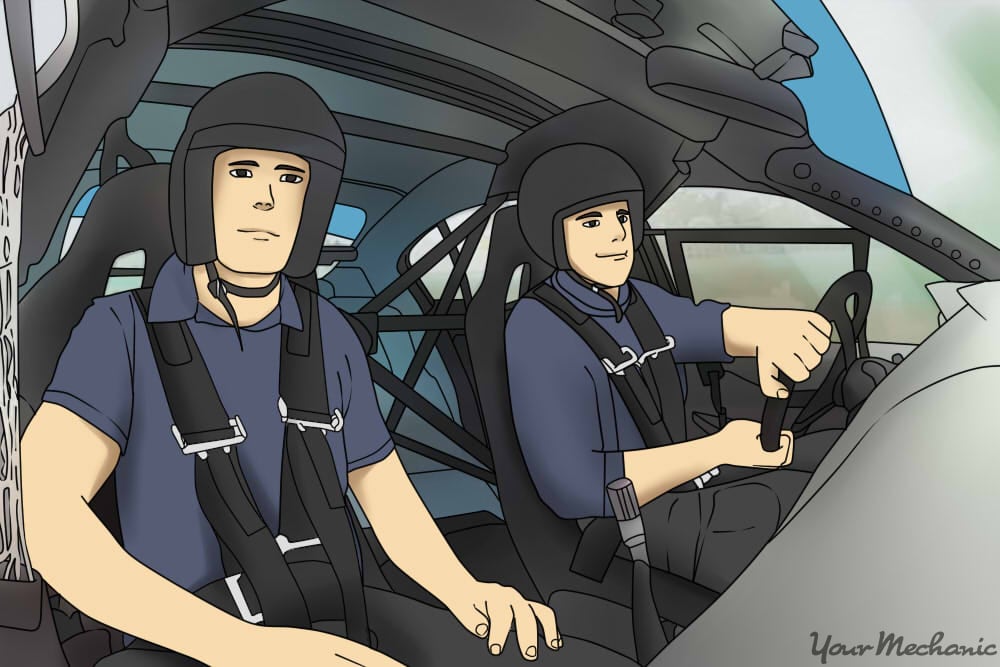

Few sports are as full of adrenaline and excitement as car racing. There’s a reason that little kids love their Hot Wheels model cars, and pre-teens love playing racing video games, and teenagers can’t wait to get behind the wheel of the car.
Car racing offers a legal and relatively safe arena to drive fast, drive hard, and drive competitively.
Like all sports, the earlier you get into race car driving, the bigger is your advantage. You can start racing as an adult and still work your way up to a highly competitive, or even professional level.
Part 1 of 4: Learn the essentials of race car driving
Step 1: Try driving a go-kart. While racing sounds fun to everyone, it’s not actually for everyone. To make sure that racing is something you’re actually interested in, first try go-karting, which is affordable and easy to get started in.
Visit a go-kart course, like the kind that teenagers go to for their birthday parties. It usually costs about $20 or $30 to try driving those karts and you’ll quickly learn if racing is for you.
Step 2: Get serious about karting. If you like driving go-karts on small courses, it’s time to move up to the real karts, which is where most professional race car drivers start out.
Check with your local race track about kart races, and see how you can get involved. A kart is a lot cheaper to own and maintain than a race car, so it is a relatively affordable way to start racing regularly while you hone your skills.
Most race tracks have kart races with some regularity, meaning you should get plenty of opportunities to get behind the wheel and start racing.
- Tip: If you have started racing at a young age, you can often gain the attention of potential sponsors and teams once you have karting success. It’s also a great opportunity to meet talented racers and learn from them.
Step 3: Take a racing class. Attend a quality race car driving class. Your local race track likely has driving classes with some regularity.
Sign up for a class that is reputable and has good reviews. If you’re still on the fence about racing, try taking a single-day course to see how you like it. If you know that you’re very interested, sign up for a longer, more intensive course, where you can really learn the skills and the strategies necessary to be a good driver.
- Tip: Always keep your eye open for more classes at your local race track. Even after you’ve taken a course, there’s still a lot more to learn, and you may be able to find intermediate or advanced driving classes available.
Step 4: Practice in your car. You should never race your vehicle on public roads, and you should never excessively speed, as both of these things put you and your fellow drivers at risk. However, you can still practice race essentials in your car.
Think of the lessons you learned in your driving courses, and see which ones are applicable in everyday driving. For instance, you can focus on looking far down the road, rather than directly in front of you and focus on hitting the apex of your turn early if it’s a single turn, or late if it’s the beginning of an S-curve.
- Tip: If your vehicle has an automatic transmission, you may want to trade it in for a car with a manual gearbox, so that you can practice shifting and get as comfortable as possible with it.
Part 2 of 4: Start competing with race cars
Step 1: Join the SCCA. Sign up for your local Sports Car Club of America (SCCA) chapter.
In order to start competing with cars, rather than karts, you’ll need to join your local chapter of the SCCA. The SCCA has frequent events at tracks all over the country, that range from basic autocrossing to serious amateur competitions.
To join the SCCA, visit their site and fill out a form. You will also need to pay a national membership due of $65 plus regional fees up to $25. Before competing, you will also have to get a physical from a doctor.
- Tip: The SCCA fees are less if you are under the age of 24 or an active member of the United States Military.
Step 2: Get a race car for yourself. If you’re just getting started with racing, you can buy a cheap car and outfit it for the race track. Get a professional to perform a pre-purchase inspection of the car, before you finalize the deal.
Older, small sports cars, such as first generation Mazda Miatas, and Porsche 914s are very popular at SCCA events, because they’re affordable and perfect for learning to drive.
- Tip: If you are buying a cheaper vehicle to learn to race in, you will need to make it race-ready by acquiring the necessary safety equipment, such as a roll cage and a five-point seatbelt.
You can also rent a sports car, if you’d rather go that route. Your local SCCA chapter will be able to direct you to a good place for renting a top quality sports car.
If you feel like making a big investment, you can also purchase a newer, fully outfitted sports car.
Step 3: Get your safety equipment and gear. Purchase all the necessary racing gear and safety equipment.
Before racing, get all the necessary gear and safety equipment in place including a fire-proof racing suit, fire-proof helmet, fire-proof gloves, fire-proof shoes, as well as a fire extinguisher.
- Note: All of your safety gear will need to be checked and approved by an SCCA official before you can race.
Step 4: Start racing. Start competing in SCCA sanctioned events.
Keep your eye on your local SCCA schedule and sign up for as many races as you can. As you race more frequently, you’ll get better at it and you can get tips and advice from other racers at such events.
- Tip: If you’re not getting your full fix of racing at your local track, look at SCCA events in nearby cities as well.
Step 5: Get your competition license. Receive your competition license from the SCCA.
When you first join the SCCA, you are considered a novice until you disprove it by getting your competition license. To graduate from novice status, you’ll have to race at least three times within the span of two years. You’ll also have to take an SCCA sanctioned racing course.
After you’ve done these things, get your novice permit from the SCCA, and have it signed by your local chapter’s Chief Steward. Then, fill out the competition license application, which you can find at an SCCA event, or on the SCCA’s website.
Part 3 of 4: Perfect your racing skills
Step 1: Practice daily. If you want to race professionally, you should be practicing at least five times a week. If you simply want to become a very talented amateur racer, you should be practicing at least once or twice a week.
To practice, you can either find more local events to participate in or see if you can find a track to rent out for an hour or two.
You can also purchase a simulator that you can use for practicing racing at home.
Step 2: Study race car driving. In addition to practicing the skills behind racing, you’ll want to focus on learning more about racing. The best professional athletes are constantly looking for new things to learn, and for new mental edges.
Purchase books and videos on racing, and watch professional races with an eye towards learning from the best in the business.
If you can, get someone to videotape your races, and then watch them later to spot any areas where you can improve.
Step 3: Take advanced racing classes. Even when you’ve become very comfortable in the driver’s seat of a race car, constantly push yourself to new heights.
When you see advanced classes coming to your local race track, sign up for them.
- Tip: Try expanding your search for classes to include courses in major cities. It is an investment to travel just to take a class, but it can really pay off, if your goal is to become a professional racer.
Step 4: Workout. It’s a common misconception that race car drivers aren’t serious athletes. In reality, racing is an endurance sport, just like long-distance running, swimming, or biking.
To get your body in shape for serious racing, start working out every day. Make sure to mix endurance training (such as running and swimming) with muscular workouts, such as weightlifting, so that you’re in great shape when you get in the car.
Train your body like a professional athlete. Focus on eating and sleeping well, and on staying hydrated. Doing these things will greatly help your stamina during a long, hot race.
Part 4 of 4: Go professional
Step 1: Get a sponsor or team. Once you start having success racing, it’s time to look for a team or a sponsor.
A team usually covers some or all of your expenses in exchange for a portion of your winnings. A sponsor will cover some or all of your expenses in exchange for advertising on your race car.
If you’re a great driver, you’ll probably get propositioned by potential sponsors and teams. If no one reaches out to you, however, start reaching out to sponsors and teams that you see at the track during racing events.
Step 2: Get a mechanic. Hire a mechanic to join you at races. A mechanic will help you get your car ready on race day, make tweaks following practice runs, and help you fix problems with your race car.
To find a mechanic, either contact your local SCCA chapter, or contact your favorite auto shop and see if anyone is willing to provide their service. You can even get one of the certified mechanics at YourMechanic to take a look at your car and perform a safety inspection, if needed.
Step 3: Sign up for big races. Once you’ve gained a reputation and earned a sponsor and/or a team, you’re ready to start competing in the bigger races.
Ask your SCCA chapter, or your team, to help you find bigger races, and enter as many of them as you can afford. If you’re good enough, these races will spiral into something even bigger.
Being a race car driver is a lot of work, but it’s also a lot of fun. If you think racing might be for you, it’s certainly worth following these steps and trying your hand at it.





